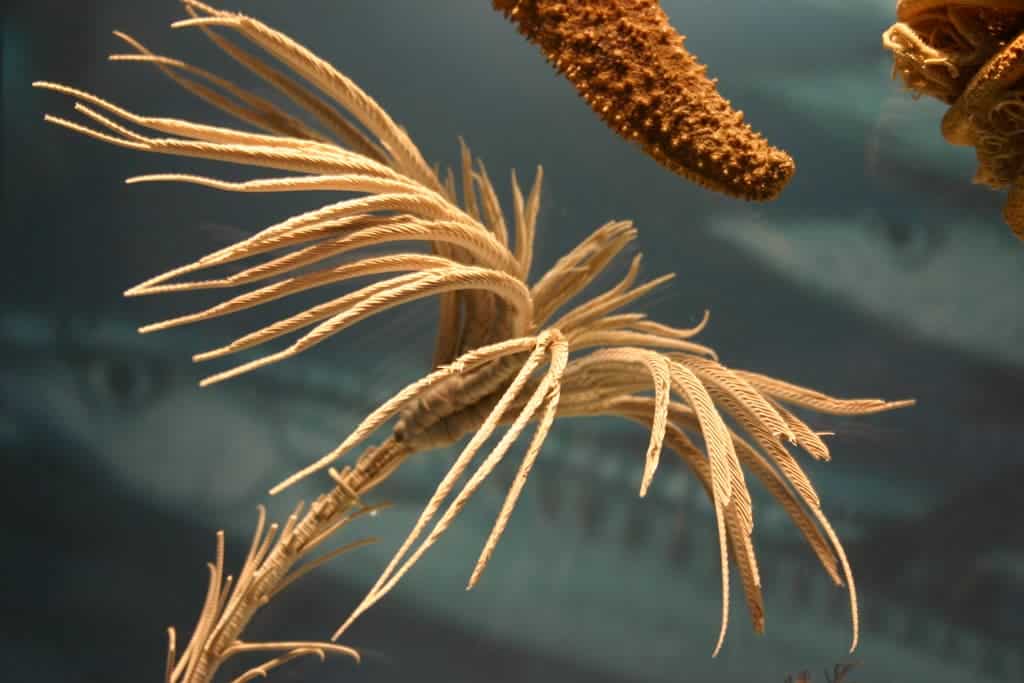Science
Related: About this forumSea lily fossil studies blossom in Guizhou geopark
Fossil restoration in the mountains requires a variety of techniques except for speaking skills-the more silent you are, the louder you will hear a stone "talk".
For Li Gang, a fossil restorer at a national geological park in Southwest China's Guizhou province, an easily ignored piece of rock might be able to convey a story dating back 220 million years.
The area was beneath the sea between 410 million and 350 million years ago. In 2006, fossils of marine reptiles and sea lilies, with a history of 220 to 230 million years, were unearthed in Guanling county. To better protect and preserve the fossils, the local government established the Guanling Fossil National Geopark, which collects and exhibits fossils of ancient marine creatures.
In his office, Li carefully places a plate-size fossil of a sea lily in a transparent container and uses sophisticated equipment to remove dust from the fossil.
"The sea lily is an animal-a kind of echinoderm to be precise. But it looks like a plant, which is why it has a plant's name," says Li.
More:
http://www.china.org.cn/arts/2020-06/12/content_76154885.htm
Judi Lynn
(160,633 posts)"It's not very often that we're challenging ideas that are almost two hundred years old," says the team.
Alexandru Micu by Alexandru Micu December 9, 2019
New research into the evolutionary history of sea lilies is setting wrong assumptions from the 1800’s right.

A modern-day sea lily.
Image credits Ryan Somma / Flickr.
Sea lilies, or ‘crinoids’, are part of an ancient lineage. Our earliest evidence of them come from around 480 million years ago, way before the dinosaurs popped in. Sea lilies are related to sea urchins and starfish, and are formed from a long slender stalk and feathery arms.
Over the last two centuries, the prevailing theory around sea lilies was that they were directly descended from ancient organisms that resembled them in shape and structure (cystoids). However, that theory has been challenged over time. The current paper aims to put that debate to rest by describing a newly-discovered species of extinct sea lily, and how it fits in the family’s evolutionary history.
A song of plates and lilies
“These early fossils provide new key evidence showing that what we had thought about the origin of sea lilies since 1846 is wrong,” says Tom Guensburg, the paper’s lead author and a research associate at the Field Museum in Chicago. “It’s not very often that we’re challenging ideas that are almost two hundred years old.”
Crinoids spend their adult lives anchored to the seafloor. Their stalks end in a cluster of feather- or fern-like arms that handle feeding: they filter plankton floating around in the water. They come in many colors and quite a variety of shapes and sizes, making them look very flower-like (hence the name).
More:
https://www.zmescience.com/science/fossil-sea-lily-evolution-8263/
~ ~ ~

Sea Lilies
Heinrich Harder
Though they largely live in the deep ocean today, during the Cambrian through the Permian, crinoid forests covered parts of the seafloor. Known as sea lilies for their beautiful, feathered arms, these creatures are cousins of modern sea stars and sea urchins. When they grew in dense groups they created a protected, diverse ecosystem for other creatures to call home. But unlike the trees that make up the forests on land, crinoids are not plants. The invertebrates feed by catching drifting particles in their many arms. In a forest full of crinoids, competition for food was tough, so they evolved a variety of stalk heights which enabled them to capture food at different levels above the seafloor. The base of their stalks was modified to anchor the animal securely in the soft sediment. Crinoids were relative skyscrapers in the community, sometimes towering at heights of up to two meters (6.5 feet). In a crinoid community, lacy bryozoans occupied a lower level. Below them, huge numbers of brachiopods monopolized the muddy bottom. By the Permian, sharks cruised above these crinoid forests, while smaller bony fishes and shelled cephalopods weaved among the crinoid stalks.
https://ocean.si.edu/through-time/sea-lilies